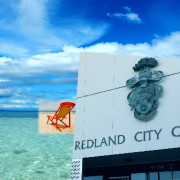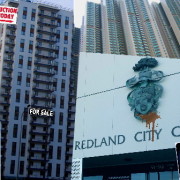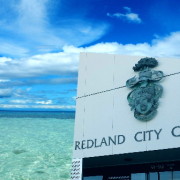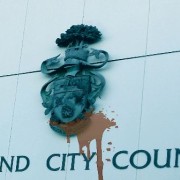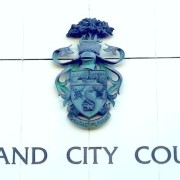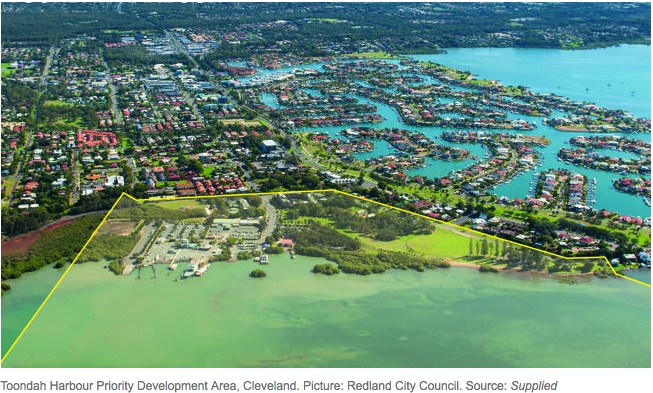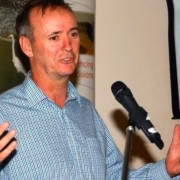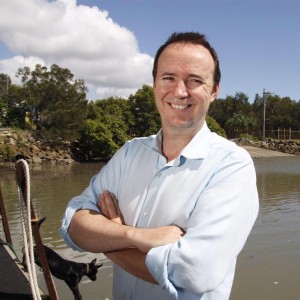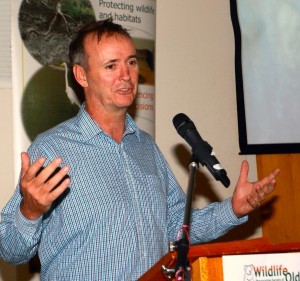Politics is the art of looking for trouble, finding it everywhere, diagnosing it incorrectly and applying the wrong remedies.
— Groucho Marx
To all of you who think that the election result was a good one because we got rid of Mayor Williams’ voting bloc, I’m going to try and persuade you – that compared with what it could have been – it was a disaster.
I’m going to conduct a post-mortem.
To start I have to answer a question I’ve been asked a few times in the last 3 months:
Why did I get involved in campaigning?
In two words the answer to is: déjà vu and irritation. I’ll do the déjà vu bit first.
When my family first arrived from the UK in 1978, we bought an old Queenslander on Cleveland Point. At the time there was talk of a section of about 20% of Raby Bay being turned into a canal development. This entailed the destruction of about 30 hectares of mangroves. Despite protest from scientists and the community, the development was approved in 1979 and was completed in 1983. With 3 different councils over the next 18 years this was extended bit by bit to include the entire area of mangroves, totalling almost 200 hectares. At each of those 4 stages it was stated that “this is the final extent of the canal development at Raby Bay” or words to that effect. This development remains the largest destruction of mangroves in Queensland. The only area that comes close is the mangroves that were destroyed to make way for the extension to the Fisherman Islands port development in the 1980s.
Take a look at these record-breaking fish catches from Moreton Bay in the 1970’s/80’s and ask yourself why they have never been repeated.
Now, nearly 40 years later, there is another marine habitat being threatened with the proposal to reclaim 60 hectares of land from the bay at Toondah and, just as with those four “final and last stages” of the Raby Bay development, there is a developer’s mayor and a bunch of developer’s councillors promoting it, whilst there’s a whole body of scientific and professional opinion – not to mention large sections of the Redlands’ community – saying it’s crazy.
That’s déjà vu. The irritation part will take a bit longer to explain.
www.Balance.org.au – the first 3 months
When I first started thinking of the forthcoming election in November last year, I naively thought most folk knew there was a developer’s mayor, Karen Williams, along with five developer’s councillors: Alan Beard; Mark Edwards; Julie Talty and Paul Gleeson. (Plus the retiring Kim Maree Hardman).
A conversation in Cleveland library in December with two gents brought a new reality home to me. These two guys – in their 60’s – 70’s, like myself – were neighbours of each other at Cleveland’s waterfront address of Oyster Point. I was surprised to find they were both largely oblivious to the 10 story apartment blocks that were planned for Toondah Harbour. Although I could tell they were both well informed about political matters generally, neither of them read the local paper and thus had little knowledge of what was about to be built right on their doorstep.
After subsequent conversations I recognized that there was a lot of apathy among the Redland voters and not just through the normal reasons for apathy – of being disengaged – but of being uninformed, they just didn’t know what was going on. A lot of people had not made the vital connection between a developer’s mayor and developer’s candidates and the terrible development decisions made by Council in the last four years. I roughly estimate that a third of the electorate went to the polls oblivious to the extent of campaign funding by developers and all the adverse outcomes this has had.
Shush – Don’t mention the war! – Basil Fawlty
Why so much ignorance on such an important topic? Well the media barely touches the subject and the candidate councillors who don’t accept funding, all failed to make anything of it. Not even to ask a question that would raise a query in people’s minds, such as: “Developer campaign funding – it’s not illegal, but is it right?”
The fact is that Karen Williams had to exit herself from the chamber on over 30 occasions over the last four years when development applications were being discussed. This proves that her election campaign was funded by the developers whose applications were, at that time, being decided upon. Now try and find that information or any of its ramifications on any of the promotional material used by councillors who didn’t accept developer’s funds. Or even tell me when they used it in any of their speeches.
Why were our preferred candidates so squeamish on such a vital vote winner? Was it fear of litigation? If so it is completely groundless. Were they not aware that you can never be taken to court for stating facts, and the facts here were incontrovertible.
Political Strategy
But this was not the only way that I think our side was very good at shooting itself in the foot when it comes to political strategizing. There was far too much talk about things that didn’t matter. For instance, I really don’t think that $$$ spent on promotional material makes much difference to election outcomes. Do you really think that the average voter decides on who to vote for by the size of or quantity of the posters? If you do, I think you’re underestimating the intelligence of your fellow residents.
In spite of the fact that local government affects the liveability of an area more than what happens at the state or federal level, most citizens want to be involved in local politics on their terms and on a piecemeal and sporadic basis, and then not as specialists, but as casual observers. So what they need is short, informative messages that have real meaning. Whinging about the size and placement of the opposition’s posters is not going to give them what they need. It’s going to result in a shrug and a confirmation in their mind how banal and uninteresting it all is. It’s certainly not going to contribute to political engagement or any vote changing behaviour in our favour.
The next concern I have is coordination. Take a look at council elections in other parts of Australia or even in the UK, where the local government electoral system is very similar to here, and you’ll see that for a team of independents to be successful they have to be that: a team. They have to stand independently on issues of specific concern to their constituents, but when it comes to the big issues that affect the whole city or shire, then they have to stand united and make something of these key concerns. And Redlands in 2016 is awash with such issues that they could and should have collectively made a lot of noise about: Secret meetings; rapidly increasing urbanisation; developer-funded candidates; Toondah; Shoreline and sewage trucks .. etc
This was how it came about that a powerful political tool – highlighting the ethical malpractice of the opposition – was left unused and rusting in the bottom of the political toolbox. So the key vote-winning concern of how to advance from a council that provides endless favours to developers to one that furthers the interests of everyone was never addressed.
Moreover there was hardly any talk at all by our preferred candidates about tactics or promoting any issues that they all agreed on, even positive ones like public transport, parkland or sports grounds. There was a total lack of a coordinated political strategy among them. It appears that because they stood as independents they thought they shouldn’t agree with each other about anything, which is absurd. They didn’t realize that getting their constituents to recognize how much is shared amongst the team of preferred candidates strengthens their overall standing. It’s a case of the collective being greater than the sum of its parts; the message becomes amplified and hence more persuasive. Our preferred candidates – who we were pinning so much hope on – never once even met up to discuss these vital issues. Electoral disaster was designed-in from the start.
Loyalty
Allied to this lack of collaboration amongst the preferred mayoral and council candidates is the question of loyalty. Each of them acted like independents but failed to realize that collectively they were each also interdependent. They needed to support each other, because if an undecided, uninformed or wavering voter detects any lack of solidarity, it can be fatal; in his or her mind, if one candidate falters they all fall. “Hang together or we’ll all be hung separately” is another way of saying it and it applies across all areas of group disagreement, be it political, legal or military.
So for example, when the Sunday Mail beat up occurred against Craig Ogilvie, other candidates should have rallied and given support. So when Greg Underwood was given the golden opportunity on ABC radio to reiterate the nonsense in this malicious piece of tabloid journalism, he should have grabbed it with two hands. He could have rubbished the Sunday Mail, explained what a beat-up it was and at the same time supported Ogilvie by explaining that Ogilvie had done very little wrong but a whole lot right. He should have highlighted the deviousness of the lady Mayor he was sitting next to who held on to the story until it inflicted the most damage. He then should have explained how Craig Ogilvie was the one councillor who took the fight to Williams about conflict of interest issues and that’s why he was targeted.
If Greg thinks that washing his hands of Ogilvie was a good tactic politically, he has now found out he was very much mistaken. His lack of support for Ogilvie was disgraceful and as demonstrated, politically, it was fatal for himself and Ogilvie. Such an action handed the most troubled Division 2 to Mitchell on a plate.
All political capital was on our side, yet we blew it.
The Business Lobby
For the last reason for our loss, we have to examine the reasons for Williams’ diminished but nevertheless unshakeable popularity. If we look at Williams’ voters, I think we’ll see that they are made up of not just those tradespeople, builders and developers that have vested interest in bricks and mortar development, but those that are in any local business. And let’s face it, it’s only natural for someone in business to vote for someone who is pro-development because they see that growing the population is the easiest way of growing their business. Many people find it difficult to think beyond their own experiences and therefore tend to make political decisions according to their own interests and circumstances.
This latter group of business owners have seen Williams as pro-growth and pro-development and thus good for their business, but when it came to local issues, traffic, mega-developments, impacts from higher densities etc., the local candidate often took the can instead of her.
Next week we’ll take this discussion about business to the next stage and ask what sort of business development do we want to see in the Redlands and why.
Summary
There appears to be little understanding that there is something substantially wrong with the way we do politics here in the Redlands. We are up against a well-resourced and popular opposition who will stop at nothing to keep control. If we keep getting it wrong we’re going to see Moreton Bay trashed and the Redlands turn incrementally into a cross between Inala and Surfers Paradise.
But that’s not the only reason why I think we must get this right. It is joined by a deeper and more worrying sense – that among so much apathy which I encountered over the last three months – somehow many have given up on, or forgotten, about all the benefits of what local government is even capable of doing for us. Such fatalism is dangerous as it can engender a despairing pessimism that demotivates any effort to get it right.
Now you know why I’m irritated.
Yes! … www.balance.org.au made mistakes too.
We prematurely forecast the demise of Mayor Williams, which was not only wrong but probably counterproductive.
And although that conversation in the library prompted my activism, it subsequently skewed my diagnosis as to who my target audience were. By early February I began to see that although there was apathy across every age group, these two guys were an anomaly and that this age demographic were in fact better informed about issues than anyone. It was younger folk, particularly the 20 – 40 year olds that were largely oblivious to council related matters. In the first half of campaign I had been reluctant to use social media at all as I was not familiar with it and I thought that much of my target audience (50yrs and over) didn’t use it much either.
But to resonate with a younger age group meant that we had to engage with social media. Doing so, for me, meant learning a whole new way to write. Informed messages have to be reduced to a soundbite; complex issues summed up in a slogan. I had to write in a tabloid fashion, something I spend my life railing against.
It was a steep learning curve and it was a case of too little too late. Only in the last few days of the campaign did our Facebook ads, videos and posts reach anything close to the critical mass required. I can see now that any future campaign effort has to start with social media, not just finish with it. Also it has to include all platforms: twitter, youtube, instagram etc.
I don’t want my website to only foretell a dire future, I want it to be a platform upon which to build a new and better one. Political science is like weather forecasting, it’s easy to give an opinion and easier still to get it wrong. I’m not certain about any of the forgoing but they are the only explanations I can think of for the poor election result. I would welcome any input and different ideas, particularly from those I’ve criticised and others in the know. It’s important that, together, we come up with a set of objectives, that, for a future occasion, we should follow and not keeping making the same mistakes. It’s a sign of insanity to keep doing the same thing over and over and expect a different result each time.
A Success Story
Let me finish by telling you about the town of Frome in Somerset in the English countryside. Independents for Frome (ifF) were a group formed in early 2011 of Frome residents who felt passionately about this market town of 25,000 people and were frustrated by the incumbent Town Council.
IfF resolved to address the apathetic disengagement, which plagued local ballots by empowering ordinary people to reclaim responsibility. For the election in May 2011, after encouragingly boisterous early debates in pubs and community halls, the movement selected and fielded seventeen candidates that were independent, but united under a common set of values, to contest every ward seat in the town
Whereas in the Redlands, generous funds for campaigning are contributed by developers, at Frome such funds were contributed by the major political parties. But it was essentially the same problem where if one party has the numbers, it can freely impose its will on everybody else. In the years preceding IfF, residents had endured a string of bungled projects and failures of consultation by an out of touch, politicised town council.
Each of the independents were frustrated about much the same things and stood collectively on a platform to introduce as much transparency and openness into the system as possible; limiting private meetings, providing easy access to minutes and decision making, and improving public involvement and consultation. They also promised a “Can Do” approach, where “…the council can, and should, be the positive hub that helps to ensure the joint success of the private, public and voluntary sectors of Frome”. And they promised “…a renewed focus on empowering people within local communities as the best way to achieve social change and civic renewal.”
In a measure clearly intended to wipe out any possibility of cronyism, all its candidates – including serving councillors – were selected by an independent panel. At this election of May 2011, IfF candidates won 10 of the 17 seats on the town council.
Immediately after their election victory, the new cohort wasted no time in dismantling the counterproductive, overly-bureaucratic council structure; replacing that moribund system with a new model based on cooperation, goodwill, common sense, and most importantly, putting the community of Frome’s best interests ahead of anything.
All ten councilors agreed that they required genuine initiatives and debate. Their new emphasis on empowerment favoured consulting with community members who have relevant expertise and then actually entrusting them with responsibilities.
The reaction of the townspeople themselves was positive: many agreed that there had been a noticeably cheerful shift in local mood. The 2011 election had seen an incredible 75% increase in voter turnout; demonstrating an optimism that was maintained throughout the first term.
Their success can be judged by the fact that in the 2015 election this group of collaborating independents took all 17 seats.
All this accomplished in just four years through a group of determined independents adopting a unified strategy.
And this is not an isolated example. In other towns throughout Britain, highly motivated groups of independents have followed Frome’s success and achieved similar feats, suggesting that what has happened in Frome and elsewhere might be achievable anywhere. An example is Alderley Edge, a sleepy village in Cheshire, where dissent was brewing and a new group of independents, called Alderley Edge First, contested every seat. On election day 2015, the sitting Conservatives lost all nine of the councils seats to this new coordinated group. All this on their first attempt.
Can Redlands repeat these success stories? Please let me know why not.
Graham Carter

